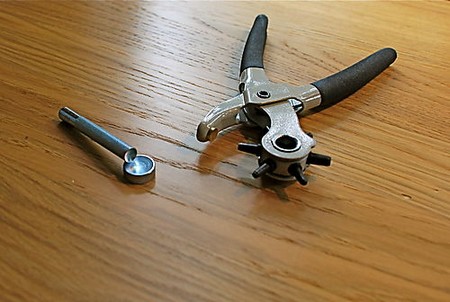Riveting is a method for making permanent joints. A rivet is basically a short metal rod with a head on one end. The head may be domed or countersunk. To make a joint, a clearance hole is drilled in the pieces to be joined, the rivet is inserted through the holes, the head supported, and the other end hammered to form a second head. Rivets are available in soft iron, mild steel, copper, brass, aluminium and aluminium alloys. This type of rivet is strong, but to use it access is needed to both sides of the pieces of metal being joined. Another type of rivet, known as a blind rivet, is essentially a short metal tube and requires access to one side of the joint only. The rivet is passed through clearance holes, as before, but is set from one side using a special tool. Blind rivets are particularly useful for fixing things to hollow objects.
Blind riveting
Most of the special tools required to set blind rivets look rather like pliers with two handles that have to be squeezed together. Some have a nozzle, some do not. With a nozzle it is easier to use the tool in awkward corners or recesses. The other fairly common tool for setting blind rivets is known as a lazy long and is operated by pushing it. Lazy tongs tend to be rather larger than plier riveters and should be used only when working on things which are strong enough to withstand pushing and firm and rigid enough not to move.

The basic principle of blind riveting is the same for all the different types of tool a rivet containing a mandrel is put in a hole, the special tool grips the end of the mandrel and the far end of the rivet is deformed by pulling the mandrel through it. Once the rivet is set the mandrel snaps off and is withdrawn with the special tool and then ejected.
The size of a rivet is defined by its diameter and its length. The diameter of a rivet determines the size of the hole that has to be drilled. (The drill size should be slightly bigger). Different diameter rivets have different diameter mandrels, and riveters have spare nozzles or swivelling turrets on their heads to cope with these different sizes. The most common rivet diameter is 3mm; 4mm rivets are also fairly easy to buy but 5mm are more difficult.
The length of the rivet needed depends on the total thickness (the grip) of the metals being joined. A rivet that is too long for the grip of the joint will need more effort to set it and will probably produce an untidy joint, but it will be strong. A rivet that is too short may not spread sufficiently to make a secure joint. When riveting soft materials, allowing enough room for a washer. Rivets made by different manufacturers vary slightly in length. In most cases with 3 and 4mm diameter rivets, short ones have a maximum grip around 3mm. medium ones around 6mm and long ones around 10mm.
Blind rivets are usually made of aluminium alloy, but mild steel rivets are also available usually in large quantities. Steel rivets are stronger than aluminium ones and. while it is possible to make structural load-bearing joints with cither type, both are normally used for cosmetic joints where the rivets have to withstand light loads only and for jobs such as holding wings or sills of cars in place before welding or brazing. For a load-bearing joint, make sure that the diameter of the rivets is not less than the thickness of the thickest material being joined. This may mean using 5mm rivets for these, lazy tongs, which require much less effort than the plier-type riveting tools, are the most sensible choice: but they are expensive and awkward to use.